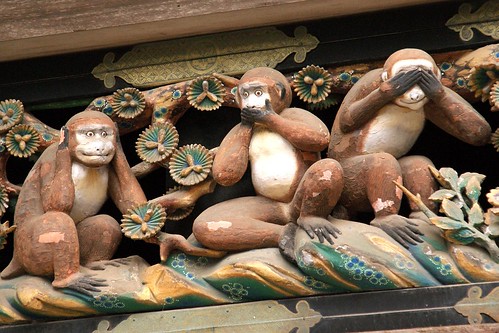In the process recently of writing a section of my
dissertation which concerns meibutsu (famed and named) tea utensils, I came
across this enigmatic little piece mentioned in a Japanese journal called 銘のはなし:十二ヶ月. Mei no hanashi: jyuni ka getsu (Kyoto: Tankosha, October 1998).
How much do I love that this tea caddy is
named "not-listening monkey" (Kikazaru)! Just look at the shape and you'll see
why it evokes one of the three famous monkeys at Nikko's Toshugu mausoleum. Awesome!
While on the face of it, the name is already charming, I believe there's also embedded grammatical pun here. The
surface reading of the name translates as "not listening monkey" but
if you consider that the "monkey" part of the name "zaru"
in this reading, is a homophone for a classical mizenkei (negating) verb
ending, then you realize that it's actually a double negative -- thus a
positive, possible to read as both "not listening monkey" AND as
"Not-not-listening" (which is actually listening). Yeah, I'm a nerd and quite possibly overthinking this double-negative business, but it's fun to contemplate these possibilities for the meaning of the name.
It is credited to Sohaku 宗伯, an Edo-era period Seto-ware potter whose dates are
unclear, though apparently he was a contemporary of Nobunaga and Hideyoshi. It
may have been named by him, but that is also not certain. The journal and other sources I've consulted don't provide a chain of ownership (yurai) entry, so I'm not even sure who owned it,
though it's a meibutsu piece. I will continue to check other meibutsuki from
the Edo era and see if I can find an entry for it.
Here's what the Japan
Knowledge Database says about Sohaku: 織豊時代の陶工。
伝記には諸説あるが,武蔵(むさし)川越(埼玉県)の人で,京都を中心に尾張(おわり)(愛知県)瀬戸,備前(岡山県)を往来し茶入れや茶碗(ちゃわん)をつくったという。また織田信長のえらんだ瀬戸六作のひとりに「俊白,一に宗伯,窯印は○印」としてこの名がある。
Either way, it's a cute piece with a very apt name, don't you agree?
There certainly are some days I can relate to not wanting to hear certain things.



No comments:
Post a Comment